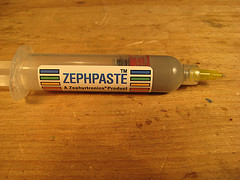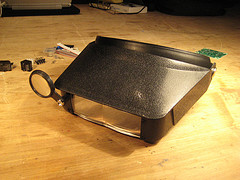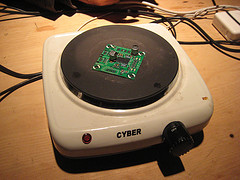SMTSolderingToolKit
Contents
Surface Mount Soldering Toolkit
See also: How to solder and How to do SMT soldering.
Here is a rough guide to the types of tools that are useful for surface mount soldering, in addition to the normal soldering toolkit that you will probably need as well. There is a really good page here and another one here that give instructions on surface-mount soldering.
Stuff You'll Need
These things are pretty important and it will be much harder to do SMT soldering without them.
Tweezers
A good pair of tweezers is priceless. The trickiest part of doing SMT work is placing the tiny components. Some you can do with fingers, and some you can do with normal tweezers, but if you have a really rock solid pair of tweezers, then life will be good. I personally use a $20 pair of tweezers called the Erem 65ASA Micro Fine with Bent Tips.
Solder Paste
The best and easiest method I've found yet for doing SMD work is the Hot Plate Reflow method. The first part of the technique is to apply solder paste to each of the SMD pads. If you don't have a stencil (and you probably don't) then its easiest to apply the solder paste with a syringe. The best solder paste I've found is Zeph Paste. It's cheap, it's high quality, and their name is pretty awesome too. They also sell applicator tips which you will need to actually apply the solder paste. I believe I use either 19 or 20 gauge tips.
Magnification Device
Having magnification for doing SMT work is really, really handy. One of the interesting things about using magnification is that your brain is able to use the extra feedback and information from the enlarged image and use it to steady your hands. For example, if you're placing components by hand you may be shaking a bit. If you do it under magnification, your brain will have extra feedback and your shaking will probably be eliminated or reduced. It seriously helps. Also, may head mounted devices like the one on the left have build-in illumination to make things even easier. I just got mine from some random electronics surplus store. Its not very good, but it works.
Hot Plate
- Main page: HotplateReflowTechnique
A hot plate is a really awesome way of soldering all your components onto the board in one shot. Just ask the Sparkfun guys! You can pick up a hotplate at your local Target/Walmart/Whatever for really cheap and they work great. Just remember not to turn the heat all the way up ;) If you have an infra-red thermometer you can use that to track the temperature of the hotplate. You're aiming for a temperature of about 220oC (but check the specification of your solder paste). You'll find that the hotplate has hot and cold spots; if this causes trouble, try putting a thick disk of aluminium or copper on it (cut from a saucepan?); they are such good conductors, the disc will even up the temperature.


